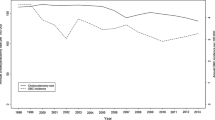Summary
Trends in mortality from cancer of the gall-bladder and bile ducts over the period 1965–1989 were analysed for 25 European countries on the basis of official death certifications from the World Health Organization databank. A high-mortality area — i.e. with overall death certification rates, world standard, around or over 2/100 000 men and 4/100000 women in 1985–1989 — was identified in Germany and the surrounding central European countries (Austria, Czechoslovakia, Hungary and Poland). The highest rates were in Hungary (3.9/100 000 men and 7.4/100 000 women). During the two decades considered, rates increased in Czechoslovakia and Hungary, remained stable in Poland and declined in Austria and Germany. Intermediate-mortality areas included Scandinavian countries (except Norway) and Switzerland: their rates in the late 1980s were between 1.5 and 2.5/100 000 men and between 2.2 and 4.2/100 000 women. Mortality increased in Finland and Sweden, declined in the Netherlands and Switzerland, and did not change consistently in Denmark. Low-mortality countries (i.e. with rates in 1985–1989 below 2.0/100 000 men and 2.5/100 000 women) included Belgium, France, Britain, Ireland, Norway, Bulgaria and Mediterranean countries. Over the last two decades, certification rates declined in Bulgaria and Great Britain, but increased in all other countries. The ratio between the countries with the highest and lowest gall-bladder cancer mortality rates declined from 21 to 12 in women, although they remained stable around 10 for men. The pattern was similar when analysis was restricted to truncated rates from patients aged between 35 and 64 years. These trends, and particularly lthe exceedingly high rates in central Europe, the low rates in Mediterranean countries and the low and declining rates in Britain and Ireland are discussed in terms of known (cholelithiasis) or potential (dietary) factors in gall-bladder cancer aetiology, and of trends in cholecystectomy rates.
Similar content being viewed by others
References
Ahlberg J, Ewerth S, Hellers G, Holström B (1978) Decreasing frequency of cholecystectomies in the countries of Stockholm and Uppsala, Sweden. Acta Chir Scand 482:21–23
Diehl AK (1980) Epidemiology of gallbladder cancer: a synthesis of recent data. JNCI 65:1209–1213
Diehl AK (1983) Gallstone size and risk of gallbladder cancer. JAMA 250:2323–2326
Diehl AK, Beral V (1981) Cholecystectomy and changing mortality from gallbladder cancer. Lancet II:187–189
Doll R, Smith PG (1982) Comparison between registries: a age-standardized rates. IARC Sci Publ 42:671–675
Fraumeni JF Jr (1975) Cancer of the pancreas and biliary tract. Epidemiologic considerations. Cancer Res 35:3437–3446
Fraumeni JF Jr, Kantor A (1982) Biliary tract. In: Schottenfeld D, Fraumeni JF Jr (eds) Cancer epidemiology and prevention. Saunders, Philadelphia pp 683–691
Friedman GD, Kannel WB, Dawber TR (1966) The epidemiology of gallbladder disease: observations in the Framingham study. J. Chronic Dis 19:273–292
La Vecchia C, Negri E, D'Avanzo B, Franceschi S, Boyle P (1991) Risk factors for gallstone disease requiring surgery. Int J Epidemiol 20:209–215
La Vecchia C, Lucchini F, Negri E, Boyle P, Maisonneuve P, Levi F (1992) Trends of cancer mortality in Europe, 1955–1989: I. Digestive sites. Eur J Cancer 28:132–235
Lowenfels AB, Lindstrom CG, Conway MJ, Hastings PR (1985) Gallstone and risk of gallbladder cancer. JNCI 75:77–80
Maclure KM, Haves KC, Colditz GA, Stampfer MJ, Speizer FE, Willett WC (1989) Weight, diet, and the risk of symptomatic gallstones in middle-aged women. N Engl J Med 321:563–569
Serra I, Calvo A, Maturana M, Sharp A (1990) Biliary-tract cancer in Chile. Int J Cancer 46:965–971
Strom BL, Hibberd PL, Soper KA, Stolley PD, Nelson WL (1985) International variations in epidemiology of cancers of the extrahepatic biliary tract. Cancer Res 45:5165–5168
World Health Organization (1950) International classification of disease: 6th revision. World Health Organization, Geneva
World Health Organization (1957) International classification of disease: 7th revision. World Health Organization, Geneva
World Health Organization (1967) International classification of disease: 8th revision. World Health Organization, Geneva
World Health Organization (1977) International classification of disease: 9th revision. World Health Organization, Geneva
Zahor Z, Sternby H, Kagan A, Uemura K, Vanecek R, Vichert AM (1974) Frequency of cholelithiasis in Prague and Malmö. An autopsy study. Scand J Gastroenterol 9:3–7
Author information
Authors and Affiliations
Rights and permissions
About this article
Cite this article
Zatonskí, W., La Vecchia, C., Levi, F. et al. Descriptive epidemiology of gall-bladder cancer in Europe. J Cancer Res Clin Oncol 119, 165–171 (1993). https://doi.org/10.1007/BF01229532
Received:
Accepted:
Issue Date:
DOI: https://doi.org/10.1007/BF01229532




